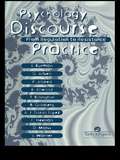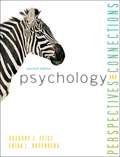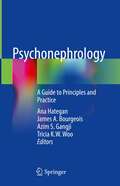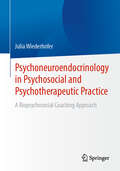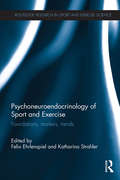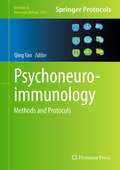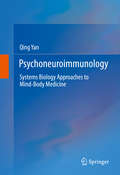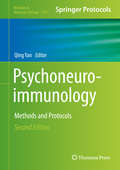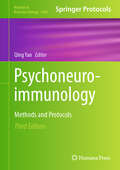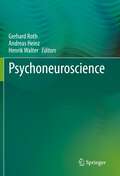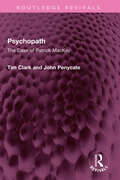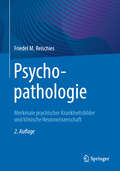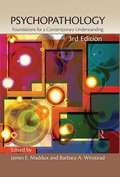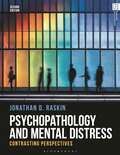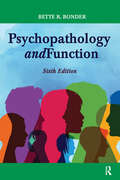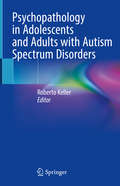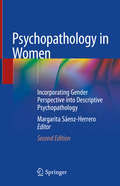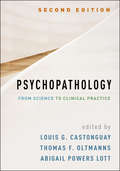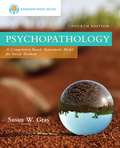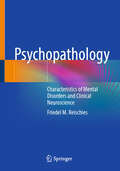- Table View
- List View
Psychology, Discourse And Social Practice: From Regulation To Resistance
by Tom Billington Sam Warner Pam Alldred Erica Burman Gill Aitken Robin Allwood Brenda Goldberg Colleen Heenan Angel Juan Gordo Lopez Debs MarkWhat damage does psychology do to people's lives, and what can we do about it? How do we recognise and support resistance? Written by expert practitioners-researchers, this co-authored book explores how psychology legislates on normality and then uses its "expert" knowledge to turn social marginalisation into pathology. Chapters address a range of cultural and institutional arenas in which inequalities structured around categories of gender, "race", class and sexuality are reproduced by psychological practices: from self-help books to special hospitals, from school exclusions to Gender Identity Clinics, from mothering magazines to mental health services. But far from just documenting the damage, this book identifies the ways in which both professionals and users of services can act to counter psychology's abuses. As practical intervention as well as theoretical critique, Psychology, Discourse and Social Practice offers tangible examples of how change can be effected. This book will be of interest to advanced undergraduates and postgraduates in psychology, health, education and welfare disciplines. It is also relevant to social workers and education and health professionals, as well as professional psychologists.
Psychology: Perspectives and Connections (2nd Edition)
by Gregory Feist Erika RosenbergIn psychology, not everything is black and white. "Psychology: Perspectives & Connections 2e " dares students to challenge their own assumptions, explore research and to not believe everything they think. The over-riding goal of "Psychology: Perspectives & Connections 2e " is to align what excites us as researchers and perpetual students of psychology with todays introductory psychology student. Feist and Rosenbergs aim is to help students understand that psychology, and much of the world around them, is more fascinating--and likely more intricate and interdependent-- than they think. Its not just black and white. And, with Connect Psychology and its adaptive learning system, students can better understand what they know and master what they dont know. Connect with science. Connect with students. Connect with Feist and Rosenbergs "Psychology 2e. "
Psychonephrology: A Guide to Principles and Practice
by James A. Bourgeois Ana Hategan Azim S. Gangji Tricia K. W. WooThe book focuses on pharmacological and non-pharmacological approaches of psychiatric syndromes that commonly occur in patients with kidney disease. It specifically reviews principles of psychotherapy and psychopharmacology with an emphasis on organ impairment and drug-drug interactions specific to nephrology. This book also covers issues with medication nonadherence in patients with chronic kidney disease and psychiatric comorbidity, as well as the associated issues in dialysis and renal transplantation. Additionally, chapters cover various other topics addressing an active stance towards health promotion in chronically ill patients, including the critical role of the diet and physical activity. Such advice is often complex and changing depending on the stage of chronic kidney disease and the individual needs of the patient. Written by specialists in the field, Psychonephrology: A Guide to Principles and Practice serves as a valuable reference and teaching tool that provides an opportunity for learning across a rapidly evolving medical field.
Psychoneuroendocrinology in Psychosocial and Psychotherapeutic Practice: A Biopsychosocial Coaching Approach
by Julia WiederhoferWhat are hormones, and what significance do they have for the psyche and our behavior? Do hormones influence our psyche and behavior? Can our behavior influence our hormones? Is there a connection between hormones and mental disorders? This book explores the interplay between the neurobiological foundations of psychological experiences and behavior, endocrine processes, and psychosocial environmental influences. It presents the foundational research of both the scientific disciplines of endocrinology and psychoneuroendocrinology in a way that is accessible to readers without medical or neurobiological backgrounds. This book demonstrates for the first time how these interdisciplinary insights can be implemented into a biopsychosocial coaching approach, which serves both to maintain and promote mental health. It is a coaching approach suitable for both psychosocial counseling and psychotherapeutic practice.
Psychoneuroendocrinology of Sport and Exercise: Foundations, Markers, Trends (Routledge Research in Sport and Exercise Science)
by Felix Ehrlenspiel Katharina StrahlerPsychoneuroendocrinology is the study of the interaction between hormones, the brain and human behaviour. This is the first book to examine psychoneuroendocrinology in the context of sport and exercise, offering a comprehensive review of current research and assessment techniques and highlighting directions for future research. The book explores the links between hormones and behaviour, and draws important conclusions for how their study will aid in the understanding of the bidirectional link between sport and behaviour, central to the psychology of sport and exercise. It presents the key hormones that underpin behaviour in a sporting context, including the description of their physiologic mechanisms and behavioural effects. The book reports benchmark standards for the assessment and analysis of hormonal influences of behaviour in sport, and examines practical issues and contexts such as emotional state, overtraining and stress. Psychoneuroendocrinology in Sport and Exercise is a breakthrough text that will be of interest to all advanced students and researchers working in the psychology and physiology of sport and exercise.
Psychoneuroendokrinologie in der psychosozialen und psychotherapeutischen Praxis: Ein biopsychosozialer Coachingansatz
by Julia WiederhoferWas sind Hormone und welche Bedeutung haben sie für die Psyche bzw. unser Verhalten? Beeinflussen Hormone unsere Psyche bzw. unser Verhalten? Kann unser Verhalten unsere Hormone beeinflussen? Besteht ein Zusammenhang zwischen Hormonen und psychischen Störungen? In diesem Buch wird das Wechselspiel zwischen neurobiologischen Grundlagen psychischen Erlebens und Verhaltens, den endokrinen Vorgängen sowie psychosozialen Umwelteinflüssen gezeigt. Dabei wird die Grundlagenforschung, sowohl der wissenschaftlichen Disziplin Endokrinologie als auch der Psychoneuroendokrinologie dargestellt und so erläutert, dass auch Leserinnen ohne medizinische oder neurobiologische Vorkenntnisse diese komplexen Wissenschaften verstehen. Dieses Buch zeigt zum ersten Mal, wie diese interdisziplinären Erkenntnisse in einen biopsychosozialen Coachingansatz implementiert werden können, der sowohl zur Aufrechterhaltung als auch zur Förderung der psychischen Gesundheit dient. Ein Coachingansatz, der für die psychosoziale und für die psychotherapeutische Praxis geeignet ist.
Psychoneuroimmunology
by Qing YanPsychoneuroimmunology (PNI) has developed rapidly in the last four decades. As a multidisciplinary area, PNI may provide a scientific basis for mind-body relationships toward the development of personalized and systems medicine. In Psychoneuroimmunology:Methods and Protocols, expert researchers in the field detail methods and protocols geared toward the development of integrative and individualized therapeutics in multiple dimensions from drugs to behaviors. Written in the highly successful Methods in Molecular BiologyTM series format, the chapters include the kind of detailed description and implementation advice that is crucial for getting optimal results in the laboratory. Thorough and intuitive, Psychoneuroimmunology:Methods and Protocols aids scientists in continuing to study holistic views for the translation of psychoneuroimmunology into better preventive and personalized medical practice.
Psychoneuroimmunology
by Qing YanThis book provides a comprehensive overview of the cutting-edge discoveries and the systems approaches related to the multi-disciplinary field of psychoneuroimmunology (PNI), which may provide the scientific basis for mind-body relationships, and aid in the development of personalized medicine. Specifically, the book focuses on the systems biology studies of complex mechanisms, such as stress and inflammation. There is strong evidence supporting the close relationship between stress, inflammation, and disorders including obesity, cardiovascular disease, diabetes, skin diseases, and sleep disorders. As inflammation is a critical connection among different diseases, further elucidating this connection may contribute to the findings of systemic therapeutic targets. Translational medicine is also addressed, by applying PNI approaches in clinical practice. A major challenge in current bioscience is the translation of basic scientific discoveries into better clinical outcomes. With the understanding of the translational implications of PNI, integrative interventions can be applied to modulate stress responses and to promote healthier behaviors. As an important feature of this book, a broad overview of the PNI-associated integrative interventions is provided. These interventions include nutritional supplements, meditation, and other mind-body strategies. From basic concepts to systems methodologies, from theoretical sources to clinical applications, Psychoneuroimmunology contributes to the understanding and development of PNI toward the establishment of personalized and mind-body medicine.
Psychoneuroimmunology, Stress, and Infection
by Herman Friedman Thomas W. Klein Andrea L. FriedmanPsychoneuroimmunology is the emerging science devoted to studying the two-way relationship between the nervous and immune systems. Psychoneuroimmunology, Stress, and Infection highlights the latest information concerning microbial infections in both man and animals as related to stress and especially stress hormones.The volume focuses on psychoneuroimmunology as it impacts the immune system in general and also the relationship between neurological events which influence susceptibility and/or resistance to infectious agents such as bacteria, fungi and viruses, as well as parasites. Prominent researchers describe the involvement of the hypothalamus-pituitary-adrenal (HPA) axis on immunity as a function of the nervous system. The text discusses hormones such as prolactin and growth hormone and steroid induced susceptibility to infection and neuropeptides, including vasoactive intestinal peptide, and substance P. The effects of catacholamines on immunity and susceptibility to infection are also covered. This reference also details the involvement of immune cells in the synthesis of neuropeptides, including hormones and endorphins, their effect on the brain as well as the effects of interleukins and tumor necrosis factor on the central nervous system. The book concludes with an interesting look at the relationship between aging, psychoneuroimmunology, and infection. Although there is much new knowledge concerning the nature and mechanism of immune responses, including the mediators involved, Psychoneuroimmunology, Stress, and Infection also presents important discussions and reviews that are long overdue and provide a major contribution to the area of biomedical knowledge in general and psychoneuroimmunology in particular.
Psychoneuroimmunology: Methods And Protocols (Methods in Molecular Biology #934)
by Qing YanThis fully-updated book provides systems-based methodologies and innovative technologies that can be used for solving complicated problems of complex systems. A wide range of theoretical and experimental approaches are introduced for practical applications, as the content explores the basic and novel concepts in psychoneuroimmunology (PNI), especially the relationships among stress, inflammation, and psychophysiological disorders, as well as various cutting-edge technologies and methods for PNI studies, including the utilizations of mouse models and vaccine models. In addition, this book focuses on translational medicine by applying PNI methods in clinical practice. As part of the Methods in Molecular Biology series, the chapters seek to provide a practical, state-of-the-art, and holistic view for the translation of PNI into better preventive and personalized medical practice. Authoritative and hands-on, Psychoneuroimmunology: Methods and Protocols, Second Edition will be of use to biomedical students and professionals at all levels who are interested in integrative studies in psychology, psychiatry, neuroscience, immunology, molecular biology, genetics, bioengineering, physiology, pathology, microbiology, systems biology, and clinical medicine.
Psychoneuroimmunology: Methods and Protocols (Methods in Molecular Biology #2868)
by Qing YanThis fully-updated third edition provides systems-based methodologies and innovative technologies that can be used for solving complicated problems of complex systems. A wide range of theoretical and experimental approaches are introduced for practical applications, as the content explores the basic and novel concepts in psychoneuroimmunology (PNI), especially the relationships among stress, inflammation, and psychophysiological disorders, as well as various cutting-edge technologies and methods for PNI studies, including the utilizations of mouse models and vaccine models. As part of the Methods in Molecular Biology series, the chapters seek to provide a practical, state-of-the-art, and holistic view for the translation of PNI into better preventive and personalized medical practice. Authoritative and hands-on, Psychoneuroimmunology: Methods and Protocols, Third Edition will be of use to biomedical students and professionals at all levels.
Psychoneuroscience
by Martin LayThe textbook builds a bridge between the "neurosciences" (theoretical and experimental neurobiology, neurology) and the "psychosciences" (psychology, psychiatry, psychotherapy) and aims to help provide the other disciplines with the most important and scientifically validated knowledge in an understandable form. The question of how mental experience and brain processes relate to each other has long been considered mysterious. In this book you will learn, based on the latest scientific findings, that the two areas form an indissoluble unity, even if we experience and study them differently. We present this unity in concrete terms in psychological-neurobiological theory and psychiatric-psychotherapeutic practice. We treat the principles of neurobiological excitation and information processing, the structure and function of the limbic system, the development of the personality and the interaction of genetic-epigenetic factors and prenatal and postnatal environmental influences, which may be favourable or unfavourable. On this basis, the exemplary presentation of important mental disorders such as addictive disorders, schizophrenic disorders, affective disorders and anxiety disorders takes place. Finally, following in the footsteps of the eminent psychotherapist Klaus Grawe, the concept of "neuropsychotherapy" is introduced and it is shown why psychotherapy and neurobiology belong together and can enrich each other. Our psychoneuroscientific approach paints a picture of man that is not based on opposites, but on an integration of psyche, brain, behavior and experience.
Psychoneurowissenschaften
by Martin LayDas Lehrbuch schlägt eine Brücke zwischen den „Neurowissenschaften“ (theoretische und experimentelle Neurobiologie, Neurologie) und den „Psychowissenschaften“ (Psychologie, Psychiatrie, Psychotherapie) und will dabei helfen, den jeweils anderen Disziplinen die wichtigsten und wissenschaftlich gesicherten Kenntnisse in verständlicher Form zu liefern. Die Frage, wie sich psychisches Erleben und Gehirnvorgänge zueinander verhalten, galt lange als rätselhaft. In diesem Buch erfahren Sie aufgrund neuester wissenschaftlicher Erkenntnisse, dass beide Bereiche eine unauflösliche Einheit bilden, auch wenn wir sie unterschiedlich erfahren und untersuchen. Diese Einheit stellen wir in der psychologisch-neurobiologischen Theorie und der psychiatrisch-psychotherapeutischen Praxis konkret dar. Wir behandeln die Prinzipien der neurobiologischen Erregungs- und Informationsverarbeitung, Aufbau und Funktion des limbischen Systems, die Entwicklung der Persönlichkeit und der dabei stattfindenden günstig oder ungünstig verlaufenden Interaktion genetisch-epigenetischer Faktoren und vorgeburtlich sowie nachgeburtlich stattfindender Umwelteinflüssen. Auf dieser Grundlage erfolgt die beispielhafte Darstellung wichtiger psychischer Störungen wie Suchterkrankungen, schizophrene Störungen, affektive Störungen sowie Angststörungen. In der Nachfolge des bedeutenden Psychotherapeuten Klaus Grawe wird schließlich in das, Konzept der „Neuropsychotherapie“ eingeführt und gezeigt, warum Psychotherapie und Neurobiologie zusammengehören, und sich gegenseitig bereichern können. Unser psychoneurowissenschaftlicher Ansatz zeichnet ein Menschenbild, das nicht auf Gegensätzen, sondern einer Integration von Psyche, Gehirn, Verhalten und Erleben beruht.
Psychopath: The Case of Patrick MacKay (Routledge Revivals)
by Tim Clark John PenycateFirst published in 1976, Psychopath is a study of Patrick Mackay who, in 1974 – with a string of muggings and killings behind him – was on trial for murder and was imprisoned in November 1975. John Penycate and Tim Clark – responsible for the controversial BBC Panorama programme on Patrick Mackay’s case – here take their investigation further and raise the important question of how the various responsible agencies which came into contact with him failed to see the danger and prevent these needless killings. Mackay passed through five mental institutions as well as approved schools, remand centres and homes. Twice he had been released from Moss Side Special Hospital – the North of England’s equivalent to Broadmoor – against the advice of his doctors. Penycate and Clark show that the signs were there for all to see. They give a detailed account of Patrick Mackay’s deterioration, from his turbulent childhood, through numerous suicide attempts, acts of violence and spells in mental and penal institutions, to his becoming London’s most notorious ‘mugger’ and a multiple killer, culminating in the final maniacal axing of his friend Father Crean, illustrated here with Mackay’s own words. This book will be of interest to students of criminology, psychology, penology, government, and media.
Psychopathologie: Merkmale psychischer Krankheitsbilder und klinische Neurowissenschaft
by Friedel M. ReischiesWie erklärt die Neurowissenschaft Bewusstseinsänderungen? Was passiert im Gehirn z.B. bei einem Angstzustand? Viele Menschen leiden irgendwann an Symptomen wie Antriebslosigkeit oder Bedrücktheit. Psychiatrische Krankheitsbilder sind psychopathologische Merkmalskomplexe, die eine genaue Beobachtung und Wertung benötigen. Hier finden Leser die Psychopathologie mit ihren neurowissenschaftlichen Grundlagen umfassend dargestellt. Systematisch und übersichtlich sind alle Symptome beschrieben. Fallbeispiele vertiefen Beobachtung und klinische Erfahrung. Jedem Kapitel folgen Definitionen, klinische Gesichtspunkte und Diagnostik. Neurowissenschaftliche Modelle sind für jede Merkmalsgruppe und spezielle Aspekte veranschaulicht. Das Buch richtet sich an Psychiater und andere Berufsgruppen aus der psychosozialen Versorgung sowie interessierte Studenten. Es hilft Untersuchenden, Patienten eine verständliche und zutreffende Erklärung ihres Symptoms zu bieten. Für die Neuauflage wurde das Werk komplett überarbeitet, aktualisiert sowie um neueste Forschungsergebnisse zu spannenden aktuellen Themen, wie z.B. zu Halluzinationen und Deep Learning ergänzt.
Psychopathologie: Vom Symptom zur Diagnose
by Theo R. PaykPsychopathologie ist die Lehre von den psychischen Störungen auf Symptom- und Syndromebene. Erst das exakte Erkennen und Beschreiben der Krankheitszeichen ermöglicht die korrekte Diagnose. In diesem Lehrbuch wird das hierzu nötige Wissen verständlich und anschaulich vermittelt. Es gliedert die Symptome nach Funktionsbereichen (Pathologie des Bewusstseins, der Wahrnehmung, der Gefühle u.a.), erklärt komplexere Syndrome, die sich auf verschiedenen Ebenen des Erlebens, Verhaltens und Handelns äußern und liefert aktuelle Erkenntnisse, notwendiges Kernwissen sowie historische Bezüge. Alles ist lernfreundlich und praxisnah aufbereitet: neben kurzen Beschreibungen der Untersuchungsmethoden zur Erfassung der Symptome bietet das Buch praktische Zusammenfassungen und anschauliche Abbildungen. "Psychopathologie": Symptome erkennen, Symptome verstehen.
Psychopathology
by Barbara A. Winstead James E. MadduxThis is the most up-to-date text about the etiology and treatment of the most important psychological disorders. Intended for first-year graduate students in clinical and counseling psychology, the third edition of Psychopathology continues to focus on research and empirically supported information while also challenging students to think critically. The first part of the book is devoted to the issues, ideas, and concepts in psychopathology. These chapters give students a set of conceptual tools that will help them read more thoroughly and critically the second half of the book, which focuses on specific disorders. Each chapter in this section provides a definition, description, and brief history of the disorder it discusses, and outlines theory and research on etiology and empirically supported treatments. The length, organization, content, and level and style of writing are consistently tailored to the audience, and the disorders discussed are the ones most frequently encountered by students in their training and subsequent clinical careers. A new section addresses child and adolescent disorders, while updated sections include dimensional approaches, the biological bases of psychopathology, learning theories, developmental psychopathology, dissociative disorders, mental health and aging, and mood disorders. This valuable teaching tool is not only appropriate for students, but also professionals, who will continue to refer to it as a reference.
Psychopathology
by Thomas F. Oltmanns Louis G. CastonguayThis authoritative text gives students and practicing psychotherapists a rich understanding of the connections between psychopathology research and clinical practice. Chapters thoroughly describe the etiology, symptoms and clinical features, course, epidemiology, and associated comorbidities of prevalent psychological disorders. Changes in diagnostic criteria in DSM-5 are addressed, where applicable. What sets this tightly edited volume apart are insightful discussions of how current empirical findings can inform assessment, case formulation, the therapeutic relationship, and intervention strategies (regardless of theoretical orientation). Each chapter is written collaboratively by leading psychopathology and psychotherapy researchers.
Psychopathology And Mental Distress: Contrasting Perspectives
by Jonathan D. RaskinThis groundbreaking core textbook offers a comprehensive overview of different approaches to the causes, assessment and treatment of psychological disorders. The book includes important diagnostic frameworks, including the new DSM-5-TR, ICD-11 and PDM, but also widens the scope of coverage beyond mainstream psychiatric models to include psychological, biological, historical, sociocultural and therapeutic approaches. Contemporary and well-balanced, this book provides an even-handed and holistic foundation, allowing students to develop a strong critical mindset while retaining a robust research-driven orientation. <P><P>This new edition: - features an innovative structure organized by presenting problem, examining each in a broad context of traditional psychiatric and alternative approaches - is grounded in lived experience of disorder: shining a spot-light on service-users through 'Case Examples' scenarios and 'Lived Experience' perspective pieces - Supports student learning and critical thinking through engaging 'Controversial Question' and 'In Depth' features - Features an attractive new layout and plenty of colour illustrations - Is supported by impressive online support features including lecture slides, a test bank, instructor manual, video library, student study questions, self-test quizzes, flashcard activities and more. <P><P>Now thoroughly updated to include the latest developments in research and clinical practice, along with enhanced in-text and online pedagogy to support instructors and learners, this book is ideal for undergraduate and graduate students on abnormal psychology, psychopathology, mental health or clinical psychology courses.
Psychopathology and Function
by Bette BonderA comprehensive guide to understanding mental health, Psychopathology and Function, Sixth Edition offers helpful insights and strategies for occupational therapists to understand the approaches of other disciplines, such as medicine, physical therapy, social work, psychology, and nursing, and work effectively in the care team. An essential occupational therapy resource for more than 30 years, Dr. Bette Bonder’s Psychopathology and Function, Sixth Edition clearly describes occupational therapy’s unique perspectives and contributions to improving the lives of those struggling with emotional and psychological challenges. The Sixth Edition offers an overview of important research and discusses current and emerging issues and knowledge of mental health issues. Readers will gain an appreciation of the centrality of occupation and meaning to mental health and quality of life as they understand how occupational therapy can emphasize and assert its value. New updates in the Sixth Edition include: • Increased emphasis on issues of social justice • Incorporation of material about the impact of the COVID-19 pandemic on mental health issues • A new chapter on gender dysphoria • A new chapter on sociocultural factors in mental disorders • A streamlined and updated pharmacology chapter • A discussion about the DSM-5 and the reactions to it 5 years after its release A great resource for occupational therapy students and practitioners, Psychopathology and Function, Sixth Edition recognizes the importance of interventions focused on quality of life. This text offers background knowledge and strategies that can support efforts to address social and situational issues.
Psychopathology in Adolescents and Adults with Autism Spectrum Disorders
by Roberto KellerThis book provides a comprehensive overview of the diagnosis, management and treatment of the psychiatric comorbidities encountered in adolescents and adults with Autism Spectrum Disorder (ASD). After discussing key issues in diagnosing ASD in adolescents and adults, the opening part of the book examines the genetics, neuroimaging and neuropsychology of ASD. Several chapters are then devoted to all of the psychiatric comorbidities such as psychosis, obsessive-compulsive disorder, depression, bipolar disorder, anxiety disorders, eating disorders etc. For each disorder, the clinical symptoms, biological basis, diagnostic criteria and treatment options are described in detail. In addition, a special chapter is devoted to people with intellectual disabilities. Thanks to its clear approach, Psychopathology in Adolescents and Adults with Autism Spectrum Disorders will be an invaluable resource for psychiatrists, psychologists and neuropsychiatrists, as well as allied mental health professionals, caring for these patients.
Psychopathology in Women: Incorporating Gender Perspective into Descriptive Psychopathology
by Margarita Sáenz-HerreroThis book examines sex and gender differences in the causes and expression of medical conditions, including mental health disorders. Sex differences are variations attributable to individual reproductive organs and the XX or XY chromosomal complement. Gender differences are variations that result from biological sex as well as individual self-representation which include psychological, behavioural, and social consequences of an individual’s perceived gender. Gender is still a neglected field in psychopathology, and gender differences is often incorrectly used as a synonym of sex differences. A reconsideration of the definition of gender, as the term that subsumes masculinity and femininity, could shed some light on this misperception and could have an effect in the study of health and disease. This second edition of Psychopathology clarifies the anthropological, cultural and social aspects of gender and their impact on mental health disorders. It focuses on gender perspective as a paradigm not only in psychopathology but also in mental health disorders. As such it promotes open mindedness in the definition and perception of symptoms, as well as assumptions about those symptoms, and raises awareness of mental health.
Psychopathology, Second Edition: From Science to Clinical Practice
by Thomas F. Oltmanns Louis G. Castonguay Abigail Powers LottThe text of choice for instructors looking for an innovative, empirically based, and practice-oriented perspective on psychopathology is now in a revised and expanded second edition with 50% new material. The volume presents state-of-the-art information on the disorders most frequently seen in clinical practice, reviewing their etiology, DSM-5 classification, symptoms and clinical features, course, epidemiology, and associated comorbidities. With the goal of integrating science and practice, each chapter also provides substantive therapeutic guidelines derived from the research. Contributors identify underlying principles of change that clinicians can draw on to improve their effectiveness and offer critical guidance for assessment, case formulation, and evidence-based intervention. New to This Edition *Chapters on new topics--suicide, sleep difficulties, and sexual dysfunction. *New chapter on an existing topic: schizophrenia. *Updated throughout with current theory, findings, and clinical advances. *Increased attention to transdiagnostic concerns.
Psychopathology: A Competency-Based Assessment Model for Social Workers (Empowerment Series)
by Susan GrayWritten by a practicing social worker, PSYCHOPATHOLOGY offers a compelling look at the current state of knowledge about mental disorders. The authors' accessible narrative blends with detailed, realistic vignettes to give you an inside look at what it means to practice psychopathology today. Part of the Cengage Empowerment Series, the fourth edition is completely up to date and thoroughly integrates the new DSM-V. It also integrates the core competencies and recommended practice behaviors outlined in the 2008 Educational Policy and Accreditation Standards (EPAS) set by the Council on Social Work Education (CSWE).
Psychopathology: Characteristics of Mental Disorders and Clinical Neuroscience
by Friedel M. ReischiesThe book provides an in-depth exploration of the relationship between psychopathology and neuroscientific foundations, focusing on how neuroscience explains changes in consciousness. It examines what happens in the brain during states such as anxiety, addressing symptoms like lack of motivation or feelings of depression that many people experience at some point. Psychiatric disorders are complex psychopathological phenomena that require detailed observation and assessment. This comprehensive resource systematically describes all symptoms, enriched with case studies that deepen both observation and clinical experience. Each chapter includes definitions, clinical perspectives, and diagnostic approaches, with neuroscientific models illustrated for each symptom group and specific aspects. Targeted at psychiatrists, other professionals in psychosocial care, and interested students, the book aids practitioners in providing clear and accurate explanations of symptoms to patients. The new edition has been thoroughly revised and updated, incorporating the latest research findings on contemporary topics, such as hallucinations and deep learning.
